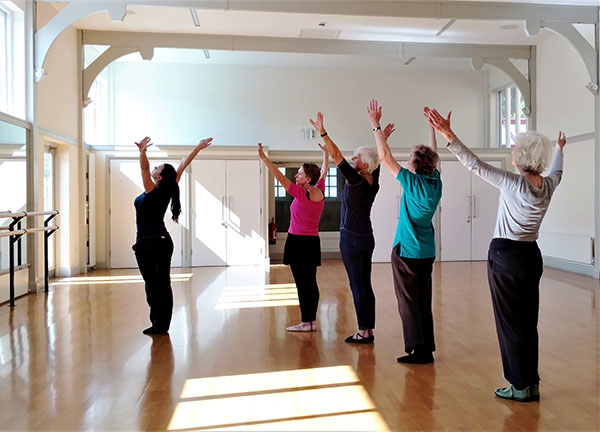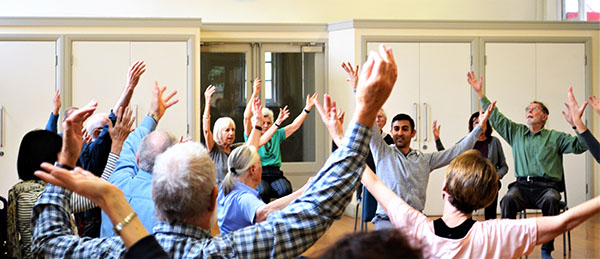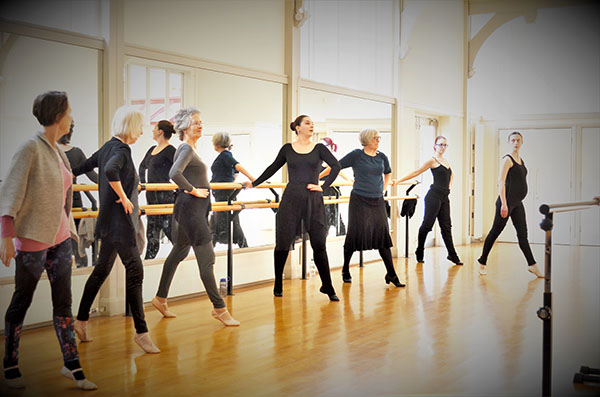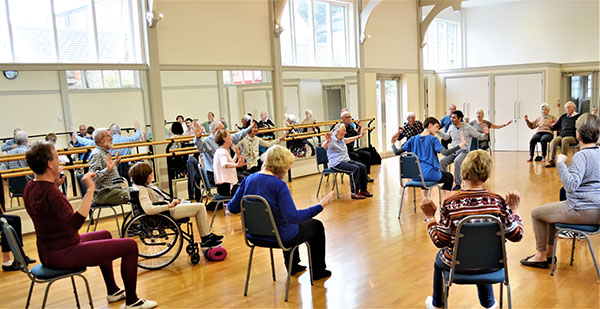Dancing Throughout Life with Ballet 4 Life
An Interview with Donna Schoenherr
BY EMMALY WIEDERHOLT
Donna Schoenherr is the founder and director of Ballet 4 Life and Move into Wellbeing® in London. In this interview, she discusses her belief that anyone can benefit from dance at any age and stage, and details how she makes dance – and specifically ballet – available to a broad range of adults.
~~
How did you come to found Ballet 4 Life?
I had been a professional dancer since I was a teenager. I landed in London with my husband, and was working as a freelance dancer, rehearsal director and choreographer, but I wanted to have a family. I was tired of traveling, so I researched what was lacking in London. I saw they didn’t have any adult ballet classes like they do very readily in America. I had a friend who had worked at Rambert Dance Company, which was also located in my neighborhood, so I looked to see if they would hire me space. That’s how Ballet 4 Life started. I wanted something local, as I didn’t want to spend over an hour on a train. I wanted to spend time with my young child. And I wanted to do something with vocational adults after working with professional dancers. It felt like the only thing I hadn’t done yet, and I could share dance with people who wanted to learn just for their own growth, exercise and wellness. That was 14 years ago.
How is Ballet 4 Life organized?
I’m the director, and I have an assistant and six teachers. We offer three to four classes per day, per week. I oversee everything, but we work collectively. We’re very prominent in the community, as we do a lot of outreach and teach free classes for schools and charities.
We function as an open studio, and we now have three locations in West London and one location in East London. People can buy class cards and attend on a drop-in basis, but we also have beginner courses. If someone comes to us as a novice, we help them climb the ladder of learning in a supportive environment. We also offer class that people can pop in to at all different levels. We have over 200 people enrolled in the program, with about 15 people on average in a class.
We offer more than ballet; we teach modern, character dance, ballroom, Latin, as well as other special master classes and workshops by different colleagues of mine. We also offer ways for our clients to connect to massage, Reiki and Feldenkrais practitioners. I bought the “Ballet 4 Life” copyright, but I also owned the “Dances 4 Life” URL rights, which was supposed to be the umbrella for everything. “Ballet 4 Life” caught on more, but it’s really a misnomer. Ballet is the core of what we offer, but we teach so much more depending on the season, the needs of our clients, and availability.
Since ballet is the crux of the program, how do you modify ballet technique so it’s approachable?
I will be very honest; I’ve done it by trial and error. I’ve created the program, and taught my teachers the methodology. We discuss what works and what doesn’t work, and modify as we go along. The loose formula I’ve come up with is gentle to the joints, and always provides a couple tiers of options for any given combination. For example, I have a 50+ ballet class in which many of the students can’t jump at all. I show them how to do the combination both without the jumps and with the jumps. I give them options. It gives people the knowledge and right to be responsible for their own bodies, and to trust their intelligence. They can stay flat if they can’t go on relevé; they can do a single frappé instead of a double; they can do a preparation instead of a pirouette. It’s never condescending with “A” groups or “B” groups. It’s just presented as different ways to approach the steps.
We stress an awareness of joints, and are also careful of avoiding mental fatigue. If something is too tricky, people clam up. We want to stimulate and challenge within boundaries, and keep the class healthy. It’s tricky, but it’s a system that works fairly well.
We offer intermediate, advanced and professional open classes as well where we have adults who have a high skill level. The 50+ ballet or beginning courses are very different from these classes. Because we don’t work with people under 16, we don’t have many dancers who are training to become professional in the classes, but we do get students on breaks. If you’re a dancer and you want to just get a good class, we can offer that. We can embrace everyone.
Because of the way the classes are offered – from complete beginner to retired professional dancer – there is a class for everybody, and we help people if they arrive at the wrong class for them.
What changes would you like to see in the professional ballet world?
This is such an ongoing challenge, but things have progressed since I was a dancer. For instance, cross training is encouraged now. When I trained, we were admonished for riding a bike because we were told it would build the wrong muscles. That’s obviously backward thinking because the best dancers understand good cross training. All the major dance companies now have cross training, like Pilates, Gyrotonic, swimming, weights, etc.
I think dancers are still too subjugated and don’t have enough rights as artists in comparison to musicians and actors. There are unions, but there could be a lot more power invested in company members instead of just the directors and stars. It is still quite male dominated too. I wish there were more female directors and choreographers.
We’re getting better with cultural diversity in ballet, but we have a long way to go. It’s starting to change, but it should have happened 20 years ago.
You also offer classes to seniors with dementia and Parkinson’s. How are those classes structured?
Move into Wellbeing® is a registered charity, which is a pretty difficult thing to get here in the UK. The government had to approve what we do. My lead teachers studied with David Leventhal of the Mark Morris Dance Company who founded Dance for PD®. I really respect what he’s doing. From there, we’ve made our own version based on the people we are and the people we work with.
We offer a dance-movement-exercise class. It’s not dumbed down, and it’s not easy. Half the class is done seated, and every exercise is choreographed to the music, just like a regular class. My lead teacher is a modern and ballet teacher, but she’s Italian, so she’s brings an Italian opera flavor with lots of gestures. You warm up the body using rhythm, patterns, clapping and voice, using the feet, legs and arms. When we get to the standing part of the class, there is another version available for those who cannot stand. They do a seated version of all the dance sequences, while those standing use a ballet barre or the back of a chair as a support. There’s always a free movement sequence through the space at the end for an expiration challenge. The classes are very dependent upon who comes and what their capabilities are, as there can be extreme differences in ability.
In thinking about all the classes you offer in both the Ballet 4 Life program as well as the Move Into Wellbeing® program, what does success look like for you and your participants?
For me, it’s just continuing to provide some sense of joy, relief and wonderment for that time we’re together in the studio. It’s a truly magical thing, and it carries on into the person’s day and week, and how it affects their self-confidence. Success for me is being able to provide that, as well as getting funding to do so. We’re always fundraising, which is hard work in the midst of teaching and developing programs. We just want to carry on doing what we do. Success can be very subtle, from a small comment about how good somebody feels after class, to a whole change in attitude, to making new friends.
~~
To learn more, check out Ballet 4 Life or Move into Wellbeing®.




